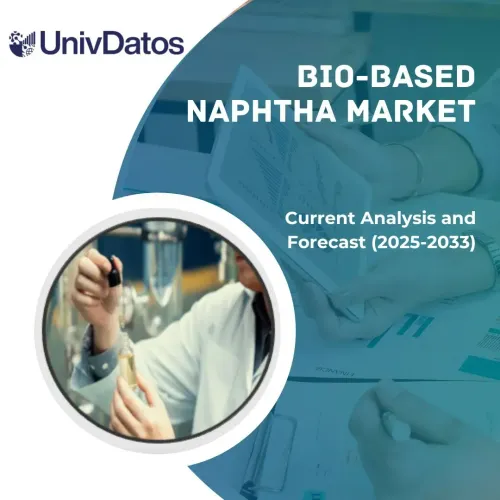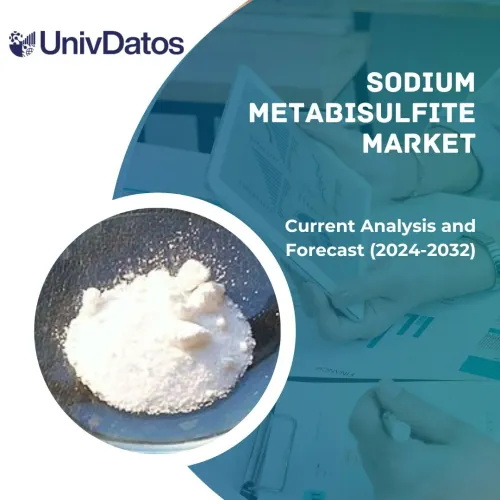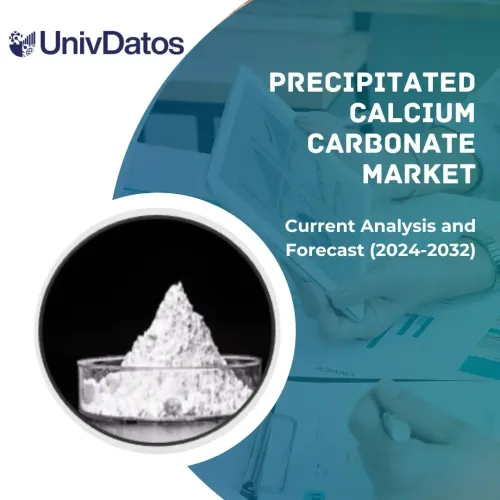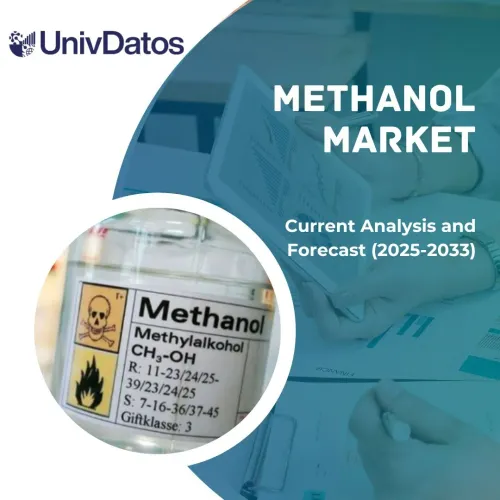- Home
- About Us
- Industry
- Services
- Reading
- Contact Us
Polymer Bearing Market: Current Analysis and Forecast (2022-2028)
Emphasis on Type of Material (Phenolics, Nylon, Teflon, Acetal, UHMWPE (Ultra High Molecular Weight Polyethylene) Others); End-User (Automobile, Medical & Pharmaceutical, Textile, Packaging, Others); Region/Country
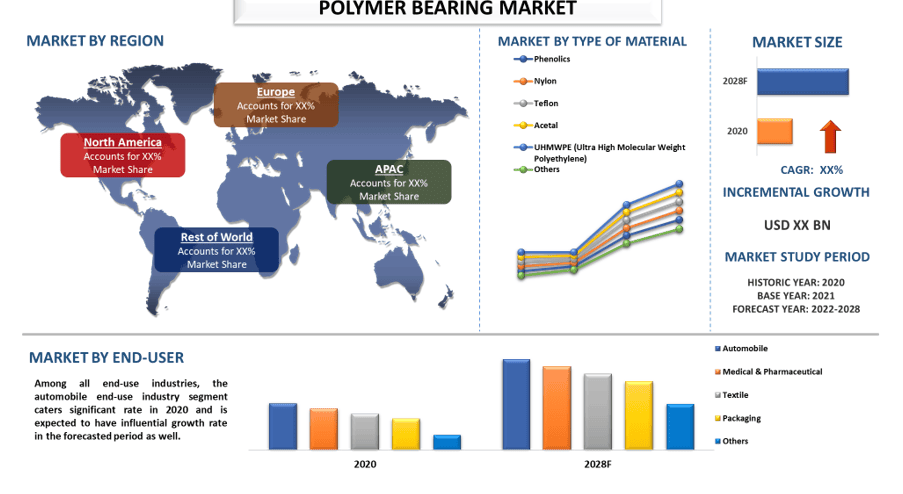
The global Polymer Bearing Market is expected to grow at a significant rate of around 4% during the forecast period. Polymer bearing is a design module used in a machine or miniature mechanism to transmit rotational motion when a minimum of one of two rubbing components is made of polymer. Factors such as increasing demand from the automobile industry are expected to boost the global polymer bearings market due to the various attributes of these bearings, such as their lubricant-free nature, high corrosion resistance, and fatigue resistance. In addition, the advancements in 3D printing technology are expected to create growth opportunities in the global polymer-bearing market. However, government regulation policies in the food and packaging industry can be a restraining factor hindering the growth of the polymer bearings market.
Furthermore, polymer bearings have several advantages over metallic or other types of bearings, such as resistance to acid, alkali, grease, wax, and solvents, corrosion resistance, their nonconductive nature, and self-lubrication, among others. Owing to these advantages, polymer bearings help reduce maintenance costs in machinery.
Some of the major players operating in the market include KMS Bearings Inc., Saint-Gobain S.A., Kilian Manufacturing, SKF, BNL Ltd., Boston Gear LLC, Oiles Corporation, IGUS Inc., Dotmar Engineering Plastic Products, and Kashima Bearings.
Insights Presented in the Report
“Amongst material type, phenolics category to witness robust CAGR during the forecast period”
Based on the type of material, the polymer bearing market is classified into Phenolics, Nylon, Teflon, Acetal, UHMWPE (Ultra High Molecular Weight Polyethylene), and Others. The phenolics segment caters substantial share of the market. As it exhibits properties such as excellent strength and shock resistance, coupled with resistance to water, acid, and alkali solutions. Phenolic polymeric materials act as self-lubricating materials and replace metal bearings in various applications.
“Amongst end-user, automobile segment to hold a significant share in the market in 2020”
Based on end-user, the polymer-bearing market is segmented into Automobile, Medical & Pharmaceutical, Textile, Packaging, and Others. The automobile segment caters considerable share of the market. In the automobile industry, polymer bearings are used to make belt tensioners, center armrests, pedal systems, gear actuators, steering systems, stub axels, and seating systems. According to OICA, in 2018 the production of light commercial vehicles and heavy trucks increased by 5.9% and 3.5% from 2017. In addition, according to International Energy Agency, in 2018, 3.29 million electric vehicles were deployed globally and the number will increase up to 125 million by 2030. This will further support market growth.
“Asia Pacific to hold a significant share in the market”
Asia Pacific is anticipated to grow at a substantial CAGR during the forecast period. This is mainly attributed to the owing to the rise in demand for polymer bearings from varied end-use industries such as automobile, textile, food processing, medical & pharmaceutical, packaging, and chemical in this region. The Asia-Pacific polymer bearings market has been witnessing consistent growth due to the increasing demand for polymer bearings in the food and beverage, delivery & logistics industries.
Reasons to buy this report:
- The study includes market sizing and forecasting analysis validated by authenticated key industry experts.
- The report presents a quick review of overall industry performance at one glance.
- The report covers an in-depth analysis of prominent industry peers with a primary focus on key business financials, product portfolio, expansion strategies, and recent developments.
- Detailed examination of drivers, restraints, key trends, and opportunities prevailing in the industry.
- The study comprehensively covers the market across different segments.
- Deep dive regional level analysis of the industry.
Customization Options:
The global Polymer Bearing market can further be customized as per the requirement or any other market segment. Besides this, UMI understands that you may have your own business needs, hence feel free to connect with us to get a report that completely suits your requirements.
Table of Content
Research Methodology for the Polymer Bearing Market Analysis (2022-2028)
Analyzing the historical market, estimating the current market, and forecasting the future market of the global Polymer Bearing market were the three major steps undertaken to create and analyze the adoption of Polymer Bearing in major regions globally. Exhaustive secondary research was conducted to collect the historical market numbers and estimate the current market size. Secondly, to validate these insights, numerous findings and assumptions were taken into consideration. Moreover, exhaustive primary interviews were also conducted, with industry experts across the value chain of the global Polymer Bearing market. Post assumption and validation of market numbers through primary interviews, we employed a top-down/bottom-up approach to forecasting the complete market size. Thereafter, market breakdown and data triangulation methods were adopted to estimate and analyze the market size of segments and sub-segments of the industry pertains to. Detailed methodology is explained below:
Analysis of Historical Market Size
Step 1: In-Depth Study of Secondary Sources:
Detail secondary study was conducted to obtain the historical market size of the Polymer Bearing market through company internal sources such as annual reports & financial statements, performance presentations, press releases, etc., and external sources including journals, news & articles, government publications, competitor publications, sector reports, third-party database, and other credible publications.
Step 2: Market Segmentation:
After obtaining the historical market size of the Polymer Bearing market, we conducted a detailed secondary analysis to gather historical market insights and share for different segments & sub-segments for major regions. Major segments are included in the report as a material type and end-user. Further country-level analyses were conducted to evaluate the overall adoption of testing models in that region.
Step 3: Factor Analysis:
After acquiring the historical market size of different segments and sub-segments, we conducted a detailed factor analysis to estimate the current market size of the Polymer Bearing market. Further, we conducted factor analysis using dependent and independent variables such as various types of material and end-user. A thorough analysis was conducted for demand and supply-side scenarios considering top partnerships, mergers and acquisitions, business expansion, and product launches in the Polymer Bearing market sector across the globe.
Current Market Size Estimate & Forecast
Current Market Sizing: Based on actionable insights from the above 3 steps, we arrived at the current market size, key players in the global Polymer Bearing market, and market shares of the segments. All the required percentage shares split, and market breakdowns were determined using the above-mentioned secondary approach and were verified through primary interviews.
Estimation & Forecasting: For market estimation and forecast, weights were assigned to different factors including drivers & trends, restraints, and opportunities available for the stakeholders. After analyzing these factors, relevant forecasting techniques i.e., the top-down/bottom-up approach were applied to arrive at the market forecast for 2028 for different segments and sub-segments across the major markets globally. The research methodology adopted to estimate the market size encompasses:
- The industry’s market size, in terms of revenue (USD) and the adoption rate of the Polymer Bearing market across the major markets domestically
- All percentage shares, splits, and breakdowns of market segments and sub-segments
- Key players in the global Polymer Bearing market in terms of the product offered. Also, the growth strategies adopted by these players to compete in the fast-growing market
Market Size and Share Validation
Primary Research: In-depth interviews were conducted with the Key Opinion Leaders (KOLs) including Top Level Executives (CXO/VPs, Sales Head, Marketing Head, Operational Head, Regional Head, Country Head, etc.) across major regions. Primary research findings were then summarized, and statistical analysis was performed to prove the stated hypothesis. Inputs from primary research were consolidated with secondary findings, hence turning information into actionable insights.
Split of Primary Participants in Different Regions
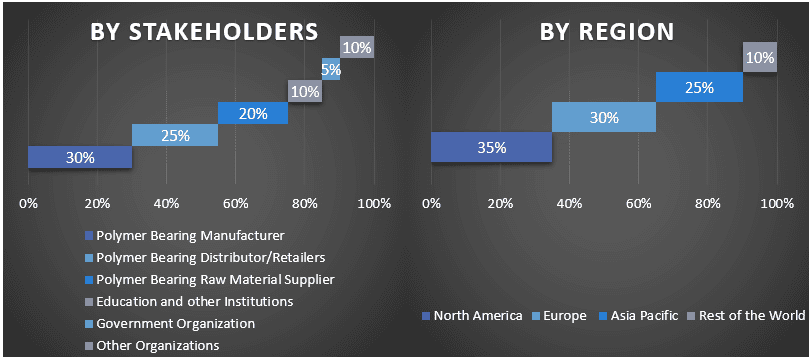
Market Engineering
The data triangulation technique was employed to complete the overall market estimation and to arrive at precise statistical numbers for each segment and sub-segment of the global Polymer Bearing market. Data was split into several segments & sub-segments post studying various parameters and trends in the areas of material type and end-user in the global Polymer Bearing market.
The main objective of the Global Polymer Bearing Market Study
The current & future market trends of the global polymer-bearing market were pinpointed in the study. Investors can gain strategic insights to base their discretion for investments on the qualitative and quantitative analysis performed in the study. Current and future market trends determined the overall attractiveness of the market at a regional level, providing a platform for the industrial participant to exploit the untapped market to benefit from a first-mover advantage. Other quantitative goals of the studies include:
- Analyze the current and forecast market size of the Polymer Bearing market in terms of value (USD). Also, analyze the current and forecast market size of different segments and sub-segments
- Segments in the study include areas of material type and end-user.
- Define and analysis of the regulatory framework for the Polymer Bearing
- Analyze the value chain involved with the presence of various intermediaries, along with analyzing customer and competitor behaviors of the industry.
- Analyze the current and forecast market size of the Polymer Bearing market for the major region.
- Major countries of regions studied in the report include Asia Pacific, Europe, North America, and the Rest of the World.
- Company profiles of the Polymer Bearing market and the growth strategies adopted by the market players to sustain in the fast-growing market
Deep dive regional level analysis of the industry
Related Reports
Customers who bought this item also bought





